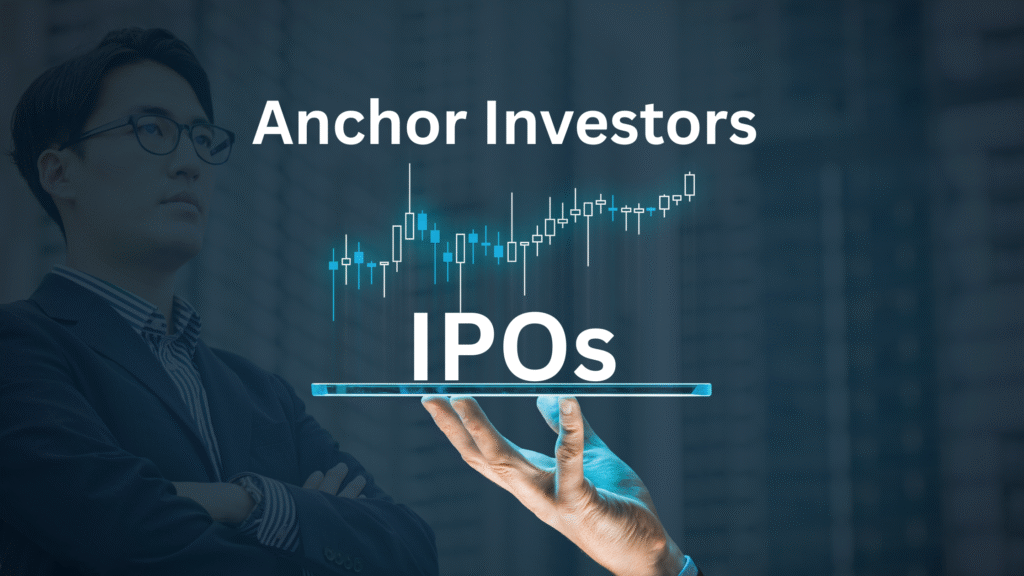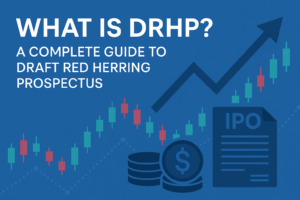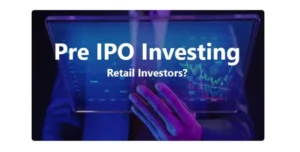Anchor Investors in IPOs: Role, Importance & Impact on Retail Investors
Introduction
Initial Public Offerings (IPOs) have become one of the most watched events in the Indian stock market. They offer investors a chance to participate in the growth story of promising companies. But before retail investors even get to bid, there’s a powerful group that makes their move: Anchor Investors.
Understanding who anchor investors are, why they matter, and how they influence the IPO process is crucial for any serious investor. This blog explores the complete picture — from regulatory rules to real-world implications — so you’ll know exactly what to look for the next time an IPO hits the market.
🏦 Who Are Anchor Investors in IPOs?
Anchor Investors are Qualified Institutional Buyers (QIBs) who are invited to subscribe to shares before the IPO opens to the general public. Their allotment happens just one day prior to the IPO opening date.
They act as a vote of confidence for the company going public, and their participation often sets the tone for the rest of the IPO journey.

✅ Eligibility: Who Can Be an Anchor Investor?
Only QIBs (Qualified Institutional Buyers) can apply as anchor investors. These include:
- Mutual Funds
- Foreign Institutional Investors (FIIs)
- Insurance Companies
- Pension Funds
- Banks
- Sovereign Wealth Funds
- Alternate Investment Funds (AIFs)
🧠 Retail investors, HNIs, and NRIs are not eligible to apply as anchor investors.
📜 SEBI Regulations for Anchor Investors
The participation of anchor investors is governed by strict SEBI (Securities and Exchange Board of India) regulations to ensure transparency and fairness:
| Rule | Description |
|---|---|
| Minimum Investment | ₹10 crore per anchor investor |
| Lock-in Period | 30 days from the date of allotment |
| Reservation | Up to 60% of the QIB portion can be allotted to anchor investors |
| Pricing | Anchor investors must bid at or above the IPO price band |
| Allotment Date | Allotment is completed one working day before the IPO opens for others |
📌 The lock-in rule ensures that anchor investors can’t exit immediately, which protects market sentiment.
🔍 Role of Anchor Investors in IPOs
Let’s break down the critical functions anchor investors perform in an IPO ecosystem:
1. Building Trust & Credibility
When reputed institutions like LIC, SBI MF, or Goldman Sachs invest as anchor investors, it sends a strong message to the market: “We’ve done our due diligence, and we believe in this company.”
This acts as social proof and increases investor confidence, especially among retail participants.
2. Price Discovery Support
Anchor investors help in:
- Validating the IPO price band
- Setting a benchmark valuation
- Encouraging institutional bidding in the QIB category
Their participation reassures that the pricing isn’t arbitrary or inflated.
3. Ensuring Subscription Success
An IPO with strong anchor demand often witnesses full subscription within minutes of opening. This momentum spills over to HNI and retail categories.
💡 Fact: Many oversubscribed IPOs in India saw 100% anchor allotments the day before opening.
4. Stabilizing Market Perception
Anchor investors reduce uncertainty. Their backing can provide short-term price support post-listing, helping avoid sharp falls on debut day.
5. Signaling Long-Term Investment Potential
Long-term or sector-specialist anchor investors are a positive sign. If a tech-focused fund anchors a SaaS IPO, it means they see strong future growth.
🔁 IPO Process Flow with Anchor Investors
Here’s a simplified view of the timeline involving anchor investors:
| Step | Activity |
|---|---|
| T-2 | Price Band and RHP published |
| T-1 | Anchor Investor bidding and allotment |
| T | IPO opens for QIBs, NIIs, and Retail Investors |
| T+3 | Allotment completed |
| T+6 | Listing on stock exchanges |
📊 Impact of Anchor Investors on Retail Investors
While anchor investors don’t directly interact with retail investors, their actions can influence retail participation and market performance.
1. Retail Subscription Trends
If a high percentage of anchor allotment is taken up by top-tier institutions, it creates positive buzz. This can lead to oversubscription in the retail category.
2. Retail Sentiment Boost
Media and brokerage firms highlight anchor investor lists, which helps average investors form opinions.
📰 Example: If mutual funds like HDFC MF or Kotak MF anchor an IPO, retail demand often spikes the next day.
3. Potential Listing Gains
Anchor investors lend credibility, which often translates into higher listing day gains due to increased demand. However, this is not a guarantee.
4. Post-Listing Volatility
Retail investors should be cautious post the 30-day lock-in expiry of anchor investors. If many choose to exit, it could pressure the stock price.
5. Strategic Entry Timing
Smart retail investors monitor anchor investor data as a pre-entry filter. It helps them avoid low-quality IPOs and identify promising opportunities.
📌 How to Evaluate Anchor Investor Participation
Here’s a checklist to evaluate anchor activity for an IPO:
| Factor | Why It Matters |
|---|---|
| Investor Quality | Is it backed by experienced institutions or unknown entities? |
| Diversity | Are there global funds, sector specialists, domestic MFs? |
| Anchor Demand | Was it oversubscribed or under-allocated? |
| Type of Fund | Long-term or short-term? Focused or diversified? |
| Historical Patterns | Have these investors profited from similar IPOs in the past? |
⚠️ Cautions Retail Investors Should Keep in Mind
- Not Always Profitable: Not all anchor-backed IPOs guarantee gains. Some anchor investors exit after lock-in, causing declines.
- Possible Speculation: Certain IPOs may use anchor participation as a marketing tactic without genuine long-term interest.
- Do Your Own Research: Never rely only on anchor list. Read the DRHP, analyze financials, and consider the company’s business model.
🧠 Real-World Case Studies
📌 Zomato IPO (2021)
- Anchor investors: Tiger Global, BlackRock, Fidelity
- Retail oversubscription: 7x
- Listing gain: ~50%
📌 Paytm IPO (2021)
- Anchor investors: BlackRock, CPPIB, ADIA
- Retail oversubscription: 1.6x
- Post-listing decline: Over 25% in first week
🎯 Lesson: Strong anchor list is a good signal but not a guarantee of success.
🤖 Tools to Track Anchor Investor Activity
- NSE/BSE RHP Disclosures
- Chittorgarh.com (Anchor investor PDFs)
- Moneycontrol IPO section
- SEBI’s official filings
✅ Final Checklist for IPO Investors Using Anchor Info
| ✅ Question | Answer |
|---|---|
| Who are the anchor investors? | Reputed institutions or unknown names? |
| What % of QIB portion is allotted? | Higher is usually better |
| Is the anchor list diversified? | Global + domestic + thematic funds is ideal |
| Is it followed by strong QIB demand? | Validates pricing and sentiment |
| Are past IPOs of similar anchors successful? | Track record matters |
Conclusion
Anchor investors in IPOs serve as the first filter and provide an institutional stamp of approval. While their presence is an important indicator of quality and sentiment, it should be part of a broader investment strategy that includes reading the DRHP, analyzing business models, and understanding valuations.
Smart retail investors treat anchor participation not as a final decision-maker but as a powerful validation signal. In the IPO ecosystem, following the smart money — with caution — can be an edge.
FAQs – Anchor Investors in IPOs
Q1. Can retail investors apply as anchor investors?
No. Only Qualified Institutional Buyers (QIBs) can participate as anchor investors.
Q2. Do anchor investors influence IPO listing gains?
They can, especially by building early momentum. But listing gains depend on demand, valuation, and market sentiment.
Q3. Is anchor investor data publicly available?
Yes. It is released one day before the IPO opens, usually via the RHP or stock exchange.
Q4. Do anchor investors always hold long-term?
No. They are required to hold for at least 30 days, but many exit afterward depending on market dynamics.
Share this content:






Post Comment